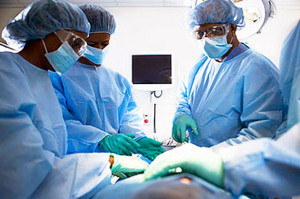Treatment Options For A Torn ACL
A torn ACL or anterior cruciate ligament is one of the most common knee injuries. The ACL injury usually occurs when the knee is hyperextended and twisted at the same time. Depending on the degree of injury, the treatment options for a torn ACL can be both surgical and non-surgical.
Symptoms of a Torn ACL
Before proceeding with a variety of treatment options for a torn ACL, an orthopedic specialist can give an accurate diagnosis.
- When the knee injury occurred, the patient heard a loud popping sound. The sound is heard when the ligaments tear.
- The sensation of pain sets in immediately.
- The knee area will swell.
- Walking and standing in place for a long period of time will be difficult.
- As the fluid builds up, the knee will be difficult to extend.
 When pain and swelling occurs, seeking medical attention should be a priority. The joint may have become heavily damage resulting in immediate care.
When pain and swelling occurs, seeking medical attention should be a priority. The joint may have become heavily damage resulting in immediate care.
Variables in Treatment
Treatment options for a torn ACL depend on different variables relating to the initial knee injury and current health status.
- The degree of injury from the torn ACL.
- The length of time between the doctor visit and the day of injury.
- The current stability of the knee when walking.
- The knee injury is limited to the torn ACL.
- The patient’s current active lifestyle.
- The current age and general health of the patient.
- The willingness to follow through with lengthy physical therapy.
Each variable will help the doctor determine the best treatment program for the torn ACL.
Non-Surgical
Treatment options for a torn ACL generally start with non-surgical options. The options are designed to be less invasive. The non-surgical approach will work if the knee is not too severely damaged.
- The best way to get back on the road to recovery is with rest. Reducing daily activity to allow the patient to keep weight off the knee will help in the healing process.
- Applying ice to the injured area to aid in reducing swelling and alleviating pain.
- While sitting or resting, keep the knee elevated with pillows or other cushions.
- Support the knee area with a brace or elastic bandage. The extra support will limit movement which will reduce the pain and swelling.
- Take either prescribed or over the counter pain medicine to help reduce symptoms.
- Follow through with all assigned exercises and physical therapy to help regain strength back to the knee area.
The non-surgical treatment options for a torn ACL are met to help restore range of motion in the knee.
Surgery
When the non-surgical treatment options for a torn ACL fail, the next step is surgery. The ACL surgery generally consists of replacing the tissue with a graft. The tissue replacement restores the connection back to the bone. For a sports related or a highly active ACL injury, an extensive rehab may be needed after surgery.
A torn ACL is a painful injury. An accurate, informed diagnosis will be needed to decide on the treatment options for a torn ACL. An orthopedic specialist, Dr. Howard Marans works with each patient individually to provide an optimal outcome. Dr. Marans accepts PPO and will work with other health insurance companies to guarantee the best result. Please click below to schedule your consultation or call us at 714.979.8981.


